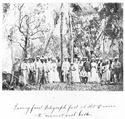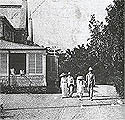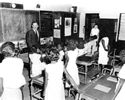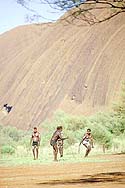

Picture album

In 1869 South Australia's Surveyor-General, George Goyder, undertook the survey of Northern Territory land – which had already been sold at auctions immediately after the Colony's annexation of this vast area in 1863. Boyle Travers Finniss had not been able to do this work from a proposed town site at the entrance to the Adelaide River in 1864–65, and Goyder set up his base camp at Port Darwin, at the foot of Fort Hill, pictured here in 1869. This camp grew into the town of Palmerston (now Darwin), its rough buildings not only serving as the Territory's first Lands Office but housing the incoming population.
Location: Northern Territory Archives Service [NTRS 234, CP 226]
Related documents

Though the completion of the overland telegraph line on 22 August 1872 was celebrated with jovial banquets in Adelaide, Melbourne and Sydney, solemnity prevailed on this occasion, marking the start of line construction, at Port Darwin on 15 September 1870. Harriet Douglas, eldest of the six children of newly arrived Government Resident Bloomfield Douglas and Ellen Douglas, proudly holds the commemorative mallet after performing the ceremonial planting of the first pole. To her left is Mary Packard, who had lived at the original survey camp at the Adelaide River in 1865; next is Ellen Douglas and the Government Resident himself stands fourth from the left. The telegraph line linked the Australian colonies to Britain via the undersea cable brought ashore at Port Darwin on 7 November 1871.
Location: Northern Territory Archives Service [NTRS 234, CP 214]
Related documents

The first engine of the first Northern Territory railway was named Port Darwin in July 1887, with a champagne christening celebrated by 'the largest crowd that has ever assembled in Palmerston', according to the Northern Territory Times. The railway ran from the Pine Creek goldfields to the Port Darwin jetty. In 1929 the line was extended to Birdum when the South Australian railway was built from Oodnadatta to Stuart, renamed Alice Springs the following year.
Location: Northern Territory Archives Service [F399, Item no. 53]

This painting by Northern Territory artist Heather Riley commemorates the official transfer of the Northern Territory from South Australia to the Commonwealth on 1 January 1911. It shows Samuel Mitchell, the Acting Administrator, and David Bevan, first Judge of the new Territory Supreme Court, with Eliza Mitchell raising the Commonwealth flag. With the transfer, Palmerston was officially renamed Darwin.
Location: Museum and Art Gallery of the Northern Territory
Related documents

The new Administrator of the Northern Territory, Dr John Gilruth, Jeannie Gilruth, their children and the family's governess explore the grounds of Government House, their new home overlooking Darwin harbour, in 1912.
Location: National Library of Australia [E J Brady Collection,]
Related documents

Territory trades unions, led by Harold Nelson, were as vigorously opposed to the administration of Dr John Gilruth as they were to the Vestey company meatworks. In November 1918, after Gilruth refused to allow Darwin's barmaids time off for the town celebrations of the end of the Great War, the conflict erupted and demonstrators massed in Liberty Square, in front of Government House. The crisis resulted in the withdrawal of the Gilruths from Darwin in February 1919 and soon after, the rebel unionists also forced the departure of Judge Bevan and other senior officials. Imprisoned for his 'no taxation without representation' campaign, Harold Nelson won the first Territory seat in the House of Representatives in 1922 and held the seat until 1934. His son, Jock Nelson, later won the seat, and in 1973 became the first Territorian to be appointed Administrator.
Location: Northern Territory Archives Service [F433, Item 24]
Related documents

Darwin became Australia's front line in the 1939–45 war when Japanese planes bombed the city and the harbour in the first air raid on 19 February 1942. The Commonwealth blue ensign flying at Government House was the first Australian flag damaged by enemy action at home and was later acquired by the Australian War Memorial.
Location: Northern Territory Archives Service [NTRS 1431, Item 8]

The seven official and seven elected Members of the Northern Territory's first Legislative Council, with Council officers, at their inaugural meeting in 1947. The Administrator was the President of the Legislative Council until 1965, when Harry Chan became the first elected President.
Location: Northern Territory Archives Service [NTRS 610, Item 32]
Related documents

Minister for Territories Paul Hasluck addressing children in a classroom at the Bagot School in Darwin in 1958.
Location: Northern Territory Library [Ref. PH0351/0048]
Related documents

A souvenir produced for the 25th anniversary of the inaugural meeting of the first fully elected Legislative Assembly of the Northern Territory on 20 November 1974 at the first Parliament House built on the Mitchell Street site of the 1872 Telegraph Station which had been destroyed by bombs in 1942. The new Country Liberal Party led by Goff Letts held 17 of the 19 seats, and Independents Ron Withnall and Dawn Lawrie the remaining two. The Territory Assembly was increased to 25 members when electoral boundaries were redrawn in 1982. A new Parliament House was opened in 1994.
Location: Legislative Assembly of the Northern Territory
Related documents

In May 1975, Gurindji people were successful in having an area of their own land excised from the Vestey pastoral lease at Wattie Creek in the Northern Territory. Here Prime Minister Gough Whitlam and Gurindji leader Vincent Lingiari celebrate the handover of the land at Daguragu. In 1986 a claim for recognition of traditional rights made under the 1976 Land Rights Act was successful and 3000 sq km of their land was transferred to Gurindji people.
Location: National Library of Australia [A6180, 26/8/75/5]
Related documents

The Supreme Court of the Northern Territory was established in 1912. This Supreme Court building in Mitchell Street, Darwin was opened in 1965 and served the Court until 1991 when the Court's premises moved to State Square. The Commonwealth Law Courts occupied the building until it was demolished in 2000.
Location: National Archives of Australia [A8763, KN24166]
Related documents

Pitjantjatjara dancers at the 'handback' of Uluru in 1984 when the Governor-General gave the traditional owners the title deeds to the area, under an arrangement requiring a lease back to the National Parks and Wildlife Service under joint management with members of the local Mutijulu community.
Location: National Archives of Australia [A8746, KN7/3/84/301]
Related documents